
Hey everyone. Before we get rolling with today’s article, I wanted to share a quick Pro-Follow update. I’m spending the day at a new basement remodel project with general contractor Joe Bianco and his team. The framers have finished, and the plumbing is underway. I’m really excited for the articles that will come out of this, so stay tuned for the full details. Connect with me through Facebook or Twitter for all the latest updates. Today, we’re bringing you a guest post by JB Bartkowiak, Editor and MC @ BuildingMoxie.com.
Here in Maryland, this winter has been extremely mild. Temperatures are in the mid 50º’s more often than not, and it seems like weeks since it has felt anything like the winters growing up. I miss snow, snow tubing (or ice skating), and chestnuts roasting on an open fire. OK, maybe I don’t actually roast chestnuts, but these, plus a good (romantic) fire or two, are just some the promises I expect of winter.
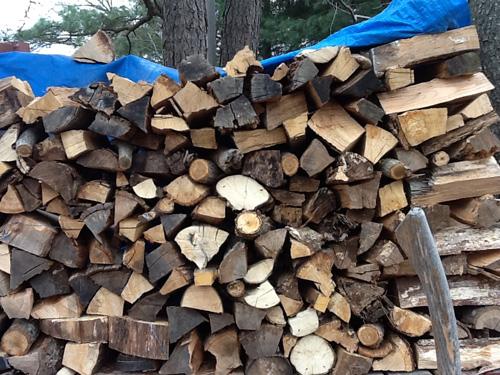
source Barry Morgan
Winter also means heating bills, and if you’re like me, the current climate (economic) has you looking for ways to save a little on those heating bills. Using your fireplace to heat your home can be a cost effective solution. Before you run off and start setting things aflame, let me share some tips for making the most of your fireplace by picking the right wood.
Burn Hot and Clean
Simply put, we want fires to burn hot, and the hottest burning woods are dense hardwoods. We also want fires to burn clean because clean burning fires produce less smoke and creosote, hence reducing the frequency at which you must clean your fireplace and chimney.
The cleanest burning woods are those that are dried (aka seasoned) properly. The presence of excess moisture in firewood forces the fire to work harder (for the same BTU output), and generally makes the resulting smoke heavier. Too much moisture allows the smoke to linger, producing more creosote within the chimney’s flue liner. This is especially dangerous when the chimney throat is constructed of metals that are at risk of rust.
“Seasoned” is just another word for dried and refers to the moisture content of the wood. Unseasoned or “green” firewood can have a moisture content as high as 60 to 80%, but the moisture content of a seasoned firewood is usually closer to 20%. There is such a thing as wood that is too dry. Woods with 10% or less moisture content will end up burning too quickly for any sort of optimal heat output.
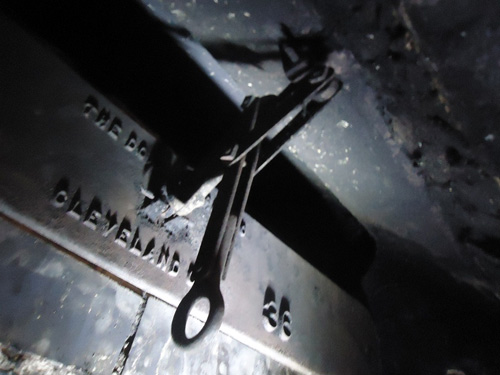
source www.BuildingMoxie.com
What’s a Cord?
There are two different types of cords; one is a full cord and the other is called a face cord. It is helpful to know that a face cord is approximately 1/3 of a full cord. Neither measurement is governed by a count of individual pieces. Rather a cord is a dimensional measurement (much like a yard of stone).
One cord of wood measures 4′ x 4′ x 8′, and it’s a lot of wood. To put this into context, it’s approximately equal to two, full-sized (Chevy or Ford) pick-up truck loads of roughly-tossed wood.
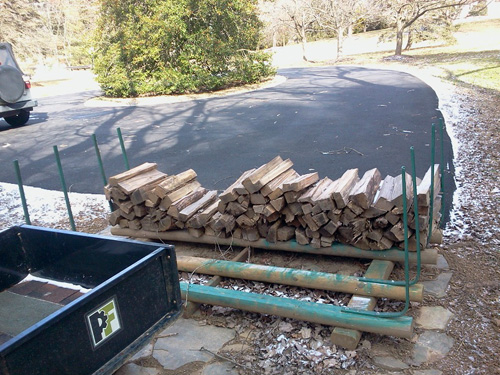
source John Bartkowiak, Jr
What is the Best Type of Firewood
When I asked chimney and fireplace contractor Cullen Davis at Clean Sweep Maryland, he says, “For larger quantities, I usually recommend Red Oak because it is affordable and easy to come by no matter where you live. I also recommended buying from someone local, a farm perhaps – someone you can trust.” For smaller quantities, a garden or home center usually does just fine; though note, these locations often offer kiln-dried wood at a slight premium.
From an impromptu panel, Ash, Hickory and even Black Locust were suggested types of firewood. Here is a very informative table from About.com that offers some more details about the best burning firewood species:
- Hickory – 25 to 28 million BTUs/cord – density 37 to 58 lbs./cu.ft.
- Oak – 24 to 28 million BTUs/cord – density 37 to 58 lbs./cu.ft.
- Black Locust – 27 million BTUs/cord – density 43 lbs./cu.ft.
- Beech – 24 to 27 million BTUs/cord – density 32 to 56 lbs./cu.ft.
- White Ash – 24 million BTUs/cord – density 43 lbs./cu.ft.
Jason Whipple, a friend who used to burn wood at his Vermont home as the primary heat source says, “Any seasoned hardwood works fine. I’ve paid a premium for fresh cut Ash in the past because it tends to cure quickly and burn well with just a month or so of drying after being cut and split.”
How to Identify Seasoned Wood & How to Season Firewood?
Properly seasoned firewood should feel relatively light, include checks (or cracks) in the ends, have almost a bleached wood color and should have an apparent lack of smell. If you bang two pieces together, they should generally produce a loud clang kinda like a baseball bat.
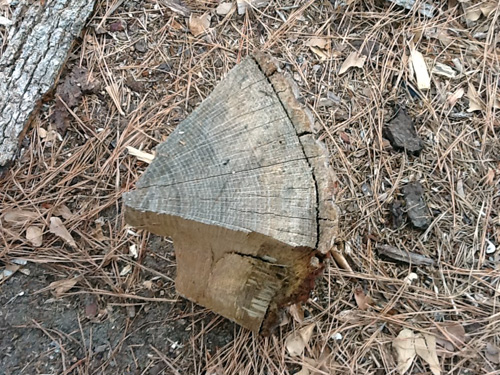
source Barry Morgan
Comparatively speaking, signs of unseasoned firewood include pieces that are relatively heavy, have a very tight end grain, a uniform wood color and a strong smell. Sap is a sure sign that a wood is green. When banging two pieces together (end to end) they create a dull thud.
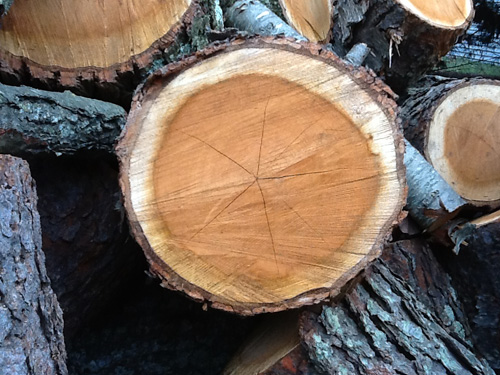
source Barry Morgan
The length of time it takes to season wood depends on the species of wood and how it’s seasoned, and seasoning falls into two categories: air-dried or kiln-dried. Each is a viable option and both offer different benefits.
If air-drying, it’s a good idea to remove the bark as it will trap the moisture. Drying times vary between woods, but for most species expect a period of 9 – 12 months. Stack the wood, ideally under cover, in a spot where the pile gets some sun and is open to the wind. In a best case scenario, you have some sort of wood shed.
While air-drying of course is the more economically of the two options, you may consider kiln-dried wood, and especially if you do not have a broad home heating need. It is said that kiln-dried wood (wood that is essentially baked at temperatures for 2-3 days) produces no creosote and generates less ash than air-dried woods.
If you order wood, don’t be shy about asking when it was cut and how long it’s been split. Jason Whipple shares, “One thing that always bugged me about some seasoned wood- they would cut the trees down in spring but wouldn’t split until it was ordered. This isn’t seasoned at all if it sits in the yard in log form. It needs to be split so it can dry out.”
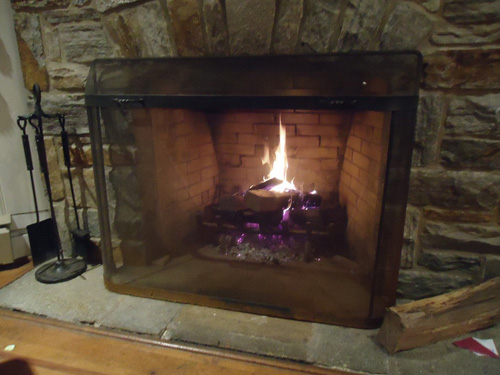
source www.BuildingMoxie.com
*******
Thanks to Britt@CalFinder, Cullen Davis, Barry Morgan, Joseph Perrone, Ryan McCracken, Jason Whipple, Jane Griswold Radocchia, David M Lyons, Joan Worthington & my Dad John Bartkowiak, Jr for help on compiling the information and images for this article.
Happy fires. ~jb @BuildingMoxie.com
*******







If you’re heating your home with an open fireplace, you’re wasting money. Almost all of the heat goes up the chimney. If you have a newer home with a vaulted ceiling in the same room as the fireplace, it’s even worse. Masonry or factory-made fireplaces simply do not direct enough heat to be useful in most homes for actual heating. If you want to heat a home, look into a wood-burning fireplace insert with a blower, or a wood-burning stove. Both of these options vent the products of combustion through the flue, but they make use of the heat produced by circulating air AROUND the unit and moving it throughout the room or home. MUCH more effective for heating.
I live in the south, where winters are fairly tame. I also have a prefabricated fireplace and a vaulted ceiling with an open floor plan. I don’t make fire for heat. I do collect the heck out of firewood, though, because the wife does like the occasional romantic fire. I have not paid for firewood in several years. Here’s how: I wait for tree crews to do the work for me. There are several kinds of tree crews with whom you can make friends. In my case, I’ve been lucky enough to run across the tree surgeons that work for the utility companies a few times. They almost never take downed trees with them. They trim back limbs and drop whole trees that have fallen on wires or will in the future. They mostly buck the trunks to a manageable length and leave them for a contracted company to pick up and haul away. They will gladly let you have the wood. They actually removed an oak in my yard, bucked it, and stacked it for me.
Storm damage is the other situation where free wood is abound. SOME tree companies will haul the wood off and sell it themselves, either as firewood or to a lumber mill. Others, and here’s where you come in, don’t bother with this. They haul the wood off, throw it in bulk dumpsters, and PAY to have it taken away. Find these tree services and make them your friends. If you have a good chainsaw, they will love you more, because they may actually just drop entire trunk sections in your yard for you to cut up.
Any time I see a tree crew in a neighborhood, I stop and ask where the wood is going. Many times, they’re taking it. But often, they’ll be willing to buck it and leave it for you to pick up later. If you do this year-round, you’ll build up a nice, staggered supply of seasoned wood.
These are fantastic tips/ideas William — I will point out that Ethan did a fantastic job trimming down a larger article I sent him (da Man!) . . . I hope to rework the left-overs into a new post for submission elsewhere (or hosting on my own site). I’d like to include your thoughts. Hope that is ok.
The original submission contained this bit which I absolutely agree with — it was actually quote straight from Wikipedia:
“It is a common misconception that a fireplace leads to energy savings by reducing the heating load on a home. In fact, a fireplace moves large amounts of air out of the home which must be replaced by outside air. The outside air, presumably at a lower temperature, must be heated by the home’s heating, ventilation, and air conditioning system.”
Thanks again for your insights. cheers super day! ~jb
Go for it. Use it all.
Really good thoughts, William. I thought I would elaborate a bit on the “fireplace waste”. You are 100% correct that fireplaces can actually cost homeowners MORE on their gas and electric bills… but there is a balance, even with open fire places. For those interested, the factors in play are:
1) How cold is the outside air? We’ve found that if the outside air is in the mid-50s, we get to what seems like a heat-neutral state in our home. Fire does put out radiant heat that heats up a room, which is sort of fighting against the cold coming in through the negative pressure created by exhaust going up the chimney. If it gets down into the 20s-40s, the effect of our fireplace, even with heatilator insert, is basically to make the family room warm, and the rest of the house cold, costing us more $ in heating. We still use it for the same reasons William does–it does add some coziness/romance.
2) Rear fireplace venting can help. My parents fireplace has a vent in the back of the fireplace to draw outside air in. You have to open the vent before starting the fire, but allows the cold air from the outside to be drawn directly into the fire. It actually works pretty well, and you dramatically reduce the negative pressure draft situation on the rest of the house. If I ever get a new house built, I want them to do this…. I think this should be standard on things like pellet stoves too. I’m not sure why you’d ever want to create a giant negative-pressure gap in a home.
Thanks for the comment, buddy!
Fred this is really interesting about rear fireplace venting — I have never come across it personally (and not when researching this article either) but it certainly would be something I’d want to investigate. Good thoughts. ~jb
I should say “have never seen back venting on an open wood fireplace.” doh! sorry and wanted to clarify. and I am very down with what is has happened with stoves in recent years. thanks love all the convo over here. ~jb
Oh, something else. While wood will certainly season faster if it’s split, it’s easier to split if it’s seasoned. It’s also easier to shave and split into kindling. So if you’ve got plenty of seasoned wood already and have to split by hand, you can save a little effort by letting the whole logs season for 9-12 months and then splitting them. Watch your shins, though. Seasoned wood has a lot more spring to it than green wood. It tends to fly off the splitting stump.
great point. I wanted to slip this . . . but! it got axed! ha! cheers.
William is right… split wood seasons much faster. But waiting to split until seasoned carries it’s own risks… Bark is firewood’s enemy. A round of wood encircled with bark can only lose moisture through the end grain. Compared to the wood, bark is a spongy material which retains moisture. This is why we like it for mulch, but it is also what fungi need to thrive. Some insects like to hang out just under the bark and they bring fungus and mold spores directly in contact with the wood. For some woods that are full of sugar like maple, or have a lighter density sap-wood outside the heart-wood, like cherry, leaving the bark on substantially increases the likelihood of rot starting.
good stuff JHade . . . chicken and egg kinda, but I’m right with you on the bark (like the tree’s skin) — problem is getting bark from a unsplit log I guess… and it’s a happy medium. great insights on fungus, insects and rot. thanks.
Craigslist can be another source for firewood – I troll the free section of our local Craigslist and there are regularly posts for people looking to get rid of a tree or with wood they just want to get rid of. Sometimes there is labor involved, but there is a post this morning from someone looking to get rid of cut-up tree sections that their electric company took down – haul it away and it is yours.
I don’t know what area of the country you’re in, but in the Atlanta area, that doesn’t happen. Down here, firewood is ONLY sold by the “stack” or the “truckload.” No one knows the actual dimensions of a cord, and people are dumb enough to buy the wet wood in a net that they sell at gas stations and grocery stores. There is no such thing as a free load of firewood on craigslist in Atlanta, unless it’s pine. I actually had a guy that was PRE-selling his trees before they had even been cut down, and they were all covered in poison ivy.
another good idea. I agree with William here in this case –you need to be cautious. I say try to think of it as any other purchase you might make and establish a “relationship” with who you buy from. ~jb
if only i had a truck…
Makes me want to go out back and start swinging my wedge. I’m with William. I let my logs season before splitting to make it easier. It’s easier yet when they are frozen. I have a bunch of ironwood that only splits when cold (or when I hook up the hydraulic splitter to the skid loader).
We rarely use our fireplace, mostly on Christmas Day. The reason? It gets so cold in the house when we do. The mantel is a pretty decorative feature, but lighting a fire is not cost effective, as William said.
What the fire is doing is creating negative pressure in the house, which draws cold air in from outside through every little crevice it can. People with wood burning inserts report this, too, because fire consumes oxygen, and pushes air up the chimney. It needs a constant influx of new air coming into the firebox.
What you try is opening the window or door nearest the fire just a crack to allow fresh air to vent into the house. This will keep the negative pressure from pulling cold air from far away parts of the house all the way into the fire room. The larger, easier draft from close to the fire will be plenty to feed it. It may make the area between the window/door and the fire colder, but that’s better than making the whole house colder.
don’t think I could have said it better than William. Cheers! ~jb
I just use whatever is free, which is why I didn’t have any wood for the last couple years, and now I have plenty. Mass got hammered with a really damaging storm in October this year, and there is STILL wood EVERYWHERE driving on the Mass Pike near Springfield is slightly surreal, the trees are almost hanging over the highway (well they WERE but those ones got removed).
That said, I got fairly lucky because most of what I have is Red Oak and Norway Maple (weeds!!!), along with an Elm that fell over my fence (I know an Elm, that was alive, its weird!).
My wife loves our fireplace primarily to be able to decorate the mantle. I have a son who ALWAYS seems to want to light a fire. I agree that fireplaces create heat loss. We usually have 2-3 fires in it per year, so I can deal with that. Thanks for the good discussion on curing firewood, and the measurement of a cord.
My mother was recently approached by a company who was contracted out by TXDOT to remove trees from the highway near her home so that they road can be widened. The company wanted to pay her to “dump” all the trees, which they removed all the branches from, in her pasture. It was great at first, but unfortunately they kept coming back even after she told them to stop. She has told anyone and everyone to come take what they want, but some of it is pilled so high we are going to have to get backhoe or something to take the pile down for safety.
It is common here in TX for there to be free wood on Craigslist as well.
cannot believe i missed this one. Fireplaces are nice. we have a ventless gas one now and would likely install the same type if our future home didn’t already come with a fireplace.
Never thought there was so much to firewood. Live and learn
BENJAMIN RAUCHER